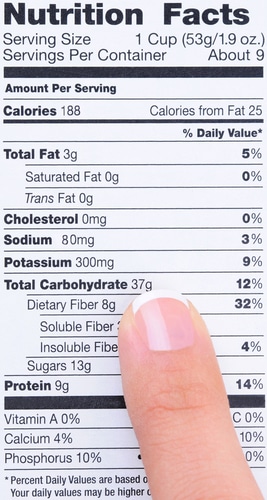
Serving Size
Serving size gets a lot of people in trouble. At the very top of the label under “nutrition facts,” you’ll see the serving size and the number of servings in the package. Look closely when buying a packaged snack like a protein bar. One bar may actually be two servings. That means you’ll have to multiply by 2 to find out how many calories you’ll be getting if you knock down the whole bar. Too many people assume that calories listed are for the whole bar and end up eating double the calories.
Fat
Beneath the calories per serving on a nutritional label, total fat is listed along with a breakdown of the type of fat. Most products show the amount of saturated fat and trans-fat a product contains. For health purposes, it’s important to keep trans-fat out of your diet as much as possible – and trans-fat labeling is deceiving. Manufacturers can say a product has zero grams of trans-fat as long as it has less than 0.5 grams per serving – so zero grams doesn’t necessarily mean zero. To see if an item has trans-fat, look at the ingredient list at the bottom of the label. If you see partially hydrogenated oils or fractionated oils, it’s not trans-fat free. Research suggests that even small amounts of trans-fat may be risky to your health. Avoid products that contain hydrogenated or fractionated oils.
Sodium
Lower is better when it comes to sodium. Many packaged products are loaded with sodium because it adds flavor to the product. The maximum amount you should get in a day is 2300 milligrams, and that’s being generous. The American Heart Association recommends keeping sodium intake under 1500 milligrams a day. If you consume a product with 500 milligrams of sodium, you’ve taken in a third of what the American Heart Association suggests before eating anything else. Look for items that have no more than 200 milligrams of sodium.
Carbohydrates, Sugar, and Fiber
Total carbohydrates are listed next on a nutritional label, along with grams of fiber and sugar. If you’re limiting carbs, calculate net carbs in a product by subtracting grams of fiber and grams of sugar alcohols from the total grams of carbs listed. Fiber and most sugar alcohols aren’t absorbed and won’t raise your blood sugar level, although some research suggests that maltitol may be partially absorbed and cause some rise in blood sugar. Choose products that have at least some fiber and are low in sugar. Most people don’t get enough fiber in their diet, and fiber helps to keep blood sugar levels more stable and hunger at bay. Women need at least 25 grams of fiber a day, while men need 38 grams or more. According to the Institute of Medicine, you should get 14 grams of fiber for every 1,000 calories you take in.
Protein
Look at the grams of protein next. Products that contain protein are usually more filling and satisfying, so having protein in a product works to keep you full longer. Keep in mind that about 15% of your calories per day should come from protein, and you may need more if you’re physically active.
Vitamins and Minerals
Just beneath the protein listing on a nutritional label, you’ll find how much of the day’s requirement of vitamins and minerals a product supplies. This is listed as a percentage and is based on a 2,000 calorie diet. If the percentages are low, the product won’t supply much nutrition for the calories you’re taking in. In other words, it’s a source of “empty calories.” Before tossing it in your basket, ask yourself if you really want to waste calories on something that has no nutritional benefits.
Ingredient List
Don’t forget to scan the ingredients. Shorter ingredient lists with names you recognize are best since this suggests the product contains fewer preservatives and other synthetic chemicals. The ingredients that are in greatest quantity in the product are listed first, so it’s not a good sign if hydrogenated oils or sugar is near the top.
The Bottom Line?
Eat whole foods whenever possible, but when you do buy a product in a package, read the label before dropping it in your cart. It could save your health.
References:
WebMD “Fiber: How Much Do You Need?”
FDA.gov “Labeling and Nutrition”
Related Articles By Cathe:
5 Food Label Deceptions to Watch Out For
Nutrition Confusion: How Many People Really Read Nutrition Labels?
How to Tell if a Food Really Has Trans-Fat
5 Ways Nutrition Labels Have Changed
Sugar and Nutrition Labels: How They May Change
Nutrition Labels: How They’re Going to Change
New Study Shows How Nutrition Labels Fool Us
Nutrition Speak: Don’t Let These Common, Nutritional Buzzwords Fool You

